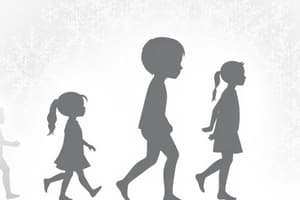Podcast
Questions and Answers
What is the primary characteristic of adolescence in terms of physical development?
What is the primary characteristic of adolescence in terms of physical development?
- Physical development plateaus
- Slow and gradual physical changes
- Significant decline in physical abilities
- Rapid physical changes, including puberty (correct)
Which developmental stage is characterized by the peak of physical development?
Which developmental stage is characterized by the peak of physical development?
- Middle Adulthood
- Early Adulthood (correct)
- Adolescence
- Late Adulthood
What cognitive development characterizes early adulthood?
What cognitive development characterizes early adulthood?
- Peak cognitive abilities in problem-solving and decision-making (correct)
- Limited cognitive growth
- Significant decline in cognitive function
- Decreasing cognitive abilities
What major life transition often occurs during middle adulthood?
What major life transition often occurs during middle adulthood?
What is a key aspect of late adulthood that requires attention?
What is a key aspect of late adulthood that requires attention?
What factor plays a crucial role in shaping an individual's physical traits and predispositions to certain developmental issues?
What factor plays a crucial role in shaping an individual's physical traits and predispositions to certain developmental issues?
What environmental factor can significantly influence growth and development throughout the lifespan?
What environmental factor can significantly influence growth and development throughout the lifespan?
Which of these is NOT a factor influencing growth and development?
Which of these is NOT a factor influencing growth and development?
What is the key difference between growth and development?
What is the key difference between growth and development?
What is a significant factor that influences both growth and development?
What is a significant factor that influences both growth and development?
What is a defining characteristic of the prenatal development stage?
What is a defining characteristic of the prenatal development stage?
Which of the following is NOT a critical period in prenatal development?
Which of the following is NOT a critical period in prenatal development?
Which developmental stage is marked by the development of self-concept and social skills?
Which developmental stage is marked by the development of self-concept and social skills?
What are the important developmental milestones that typically occur during infancy and toddlerhood?
What are the important developmental milestones that typically occur during infancy and toddlerhood?
What role does play play in early childhood development?
What role does play play in early childhood development?
During middle childhood, what cognitive development typically occurs?
During middle childhood, what cognitive development typically occurs?
Flashcards
Human development
Human development
A process involving physical, cognitive, social, and emotional changes throughout life.
Growth vs. Development
Growth vs. Development
Growth refers to size increase; development involves skill and behavior changes.
Nature vs. Nurture
Nature vs. Nurture
Development is influenced by genetic predispositions (nature) and environmental factors (nurture).
Prenatal development stages
Prenatal development stages
Signup and view all the flashcards
Teratogens
Teratogens
Signup and view all the flashcards
Milestones in infancy
Milestones in infancy
Signup and view all the flashcards
Play in Early Childhood
Play in Early Childhood
Signup and view all the flashcards
Middle Childhood features
Middle Childhood features
Signup and view all the flashcards
Adolescence
Adolescence
Signup and view all the flashcards
Cognitive Development in Adolescence
Cognitive Development in Adolescence
Signup and view all the flashcards
Emerging Sexuality
Emerging Sexuality
Signup and view all the flashcards
Early Adulthood
Early Adulthood
Signup and view all the flashcards
Middle Adulthood Changes
Middle Adulthood Changes
Signup and view all the flashcards
Late Adulthood
Late Adulthood
Signup and view all the flashcards
Factors Influencing Development
Factors Influencing Development
Signup and view all the flashcards
Social Interactions
Social Interactions
Signup and view all the flashcards
Study Notes
Overview of Growth and Development Across the Lifespan
- Human development is a complex process encompassing physical, cognitive, social, and emotional changes throughout life.
- Growth refers to quantifiable increases in size and physical attributes, while development encompasses progressive changes in skills, abilities, and behaviors.
- Development is influenced by nature (genetic predisposition) and nurture (environmental factors), interacting continuously to shape the individual.
- Significant variations exist in developmental rates among individuals due to diverse genetic and environmental factors.
Prenatal Development
- Prenatal development spans from conception to birth, marked by rapid cellular division and differentiation.
- This phase is crucial for establishing the foundation for future growth and development.
- Three distinct stages: germinal, embryonic, and fetal.
- Critical periods: specific windows during which environmental influences deeply affect development. Exposure to teratogens (e.g., alcohol, drugs) during these periods can severely impact the fetus.
Infancy and Toddlerhood (0-3 years)
- Marked by extraordinary physical growth and development.
- Rapid brain development forms the basis for cognitive, motor, and language skills.
- Milestones include initial motor skills (rolling, crawling, walking), grasping and manipulating objects, and language development (babbling, first words).
- Attachment to caregivers strongly influences social and emotional development.
- Nutrition and early childhood experiences significantly impact this period.
Early Childhood (3-6 years)
- Continued physical growth alongside marked cognitive and language development.
- Increased independence and exploration of their environment.
- Development of self-concept, social skills, and emotional regulation.
- Play is essential for learning and development.
- Exposure to diverse experiences greatly stimulates development.
Middle Childhood (6-12 years)
- Physical growth slows compared to earlier years, but continues steadily.
- Cognitive abilities mature, leading to increased abstract thinking and problem-solving skills.
- Increased social interaction with peers leads to the development of social skills and identity.
- Development of moral reasoning and understanding of social rules.
- Academic achievement and peer relationships become increasingly influential.
Adolescence (12-18 years)
- Characterized by rapid physical changes, including puberty.
- Significant cognitive development, particularly in abstract thinking and reasoning.
- Formation of identity and exploration of values, beliefs, and roles.
- Increased independence and autonomy from family.
- Emerging sexuality and development of intimate relationships.
- Social pressure and peer influence are strong factors.
- Risk of mental health challenges such as anxiety and depression is higher.
Early Adulthood (18-40 years)
- Physical development reaches its peak.
- Peak cognitive abilities, particularly in problem-solving and decision-making.
- Establishment of career paths, intimate relationships, and parenting.
- Development of personal values and beliefs.
- Increased emotional regulation and responsibility.
- Exploration of different phases of life.
Middle Adulthood (40-65 years)
- Physical changes become more evident, such as gradual decline in strength and sensory acuity.
- Continued cognitive development with ongoing learning and knowledge acquisition.
- Maintaining existing relationships and establishing new ones.
- Potential for career transitions and re-evaluation of life goals.
- Often a time for focusing on family and community.
- Addressing health concerns and potential physical limitations.
Late Adulthood (65+ years)
- Gradual physical decline impacts mobility and sensory function.
- Cognitive abilities may show some decline, typically in areas like processing speed.
- Maintaining social connections and mental stimulation is crucial to combat potential cognitive decline.
- Adjusting to retirement and navigating loss and grief.
- Dealing with health conditions and disabilities.
- Maintaining a sense of purpose and fulfillment is key.
Factors Influencing Growth and Development
- Genetics: Hereditary factors greatly shape physical traits and predispositions to developmental issues.
- Environment: Environmental factors (socioeconomic status, nutrition, healthcare access, and cultural norms) significantly influence growth and development.
- Health: Physical and mental health conditions affect development throughout life.
- Experiences: Positive and negative life experiences impact emotional, social, and cognitive development.
- Social Interactions: Relationships and interactions with others are vital for social and emotional growth.
Studying That Suits You
Use AI to generate personalized quizzes and flashcards to suit your learning preferences.




